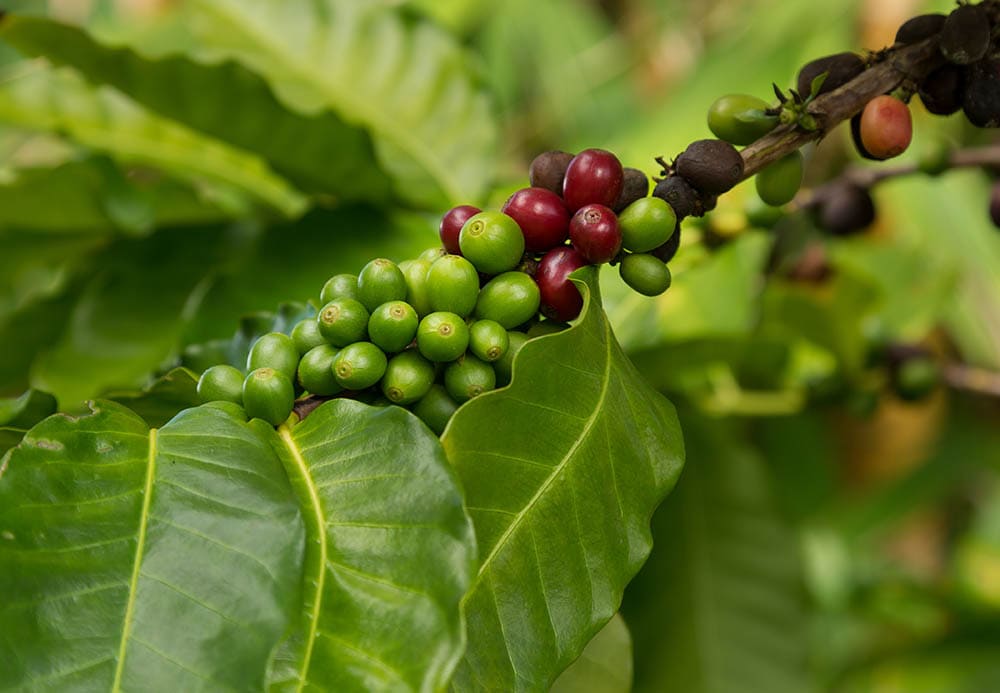
Note: This article’s statistics come from third-party sources and do not represent the opinions of this website.
Coffee is one of the world’s most popular non-alcoholic drinks and because of the weight of coffee material used to make a cup, it has a higher global market value than tea, although more tea is drunk globally. Coffee is prized for its flavor, but also for its caffeine content, and for the variety of different beverages that can be made with the addition of additives including milk and sugar.
The global coffee industry changed during the Covid pandemic, with fewer people able to leave the house and visit coffee shops and more people buying coffee machines to make their own coffee at home. It is also blighted by volatile prices and producers are heavily reliant on crop yield, which is expected to be hit by climate change and other prevailing factors.
Below are 18 facts about the global coffee industry, as well as some statistics and figures on US and European coffee consumption.
Click below to jump ahead:

Top 18 Coffee Industry Statistics
- 167 million 60kg bags of coffee were consumed in 2020–2021.
- 1.2 million metric tons of certified coffee were sold in 2020, up from 1.08 million in 2019.
- Arabica and Robusta beans make up 99% of coffee consumed.
- Brazil remains, by far, the world’s largest producer of coffee.
- Vietnam, Colombia, and Indonesia are also considered major coffee producers.
- The Finnish are the world’s greatest coffee consumers.
- All of the world’s 10 leading coffee consuming countries are in Europe.
- UK customers pay more for their coffee than any other people.
- The US is the world’s largest importer of coffee.
- In 2022, the US population spent an average of $270 per person, on coffee.
- In 2025, it is expected that 21% of coffee sold will be in out-of-home venues.
- 62% of Americans drink coffee every day.
- The average American coffee drinker consumes 3 cups a day.
- More than 70% of consumers prefer to prepare their coffee at home.
- 68% of people drink coffee while working.
- 53% of consumers want to buy ethical coffee.
- Starbucks is the largest coffee chain in the world, followed by Costa Coffee and Dunkin Donuts.
- Nescafe is the largest coffee brand of all.


Global Coffee Statistics
1. 167 million 60kg bags of coffee were consumed in 2020– 2021.
(ICO)
The world really does love coffee. Whether it’s instant or brewed, and whether it is consumed at home or in a coffee shop, accompany a meal in a restaurant, or bought from a coffee stand and drunk on the go, it all starts from the raw coffee bean. Although the coffee year 2020/2021 was affected by the Covid pandemic, 167 million bags of coffee were consumed during the year. Each bag weighs 60kg, which means that a total of just over 10 million metric tons of coffee were consumed during the 12-month period.

2. 1.2 million metric tons of certified coffee were sold in 2020, up from 1.08 million in 2019.
(Mordor Intelligence)
There continues to be an increase in interest and demand for ethically sourced coffee and there are various certification schemes concerned with coffee growing and sourcing. The best known are Fairtrade, which aim to ensure that coffee growers are treated fairly in exchange for high quality products, and the Rainforest Alliance, which aims to promote sustainability while also improving farmers’ lives. 1.2 million metric tons of certified coffee were sold in 2020, accounting for approximately 10% of all coffee sold and up from 1.08 million the year before.
3. Arabica and Robusta beans make up 99% of coffee consumed.
(Intracen)
There are four different types of coffee bean: Robusta, Arabica, Excelsa, and Liberica.
- Arabica makes up approximately 60% of all coffee beans. They are considered smooth with complex flavors and little harshness, but they are difficult to grow.
- Robusta is the second most common coffee bean. It’s less expensive and easier to grow but it has a reputation for being more bitter.
- Liberica beans come from Liberia, and they are known to have a floral to woody taste.
- Excelsa coffee beans are described as being fruity but tart and have lower caffeine content than other beans.
99% of all coffee beans consumed are either Arabica or Robusta.

4. Brazil remains, by far, the world’s largest producer of coffee.
(Statista 1)
Brazil is still the world’s largest coffee producer. Its tropical climate and rich soil, as well as its huge land mass, makes it the ideal location to grow coffee trees. Furthermore, in recent years, the government has introduced subsidies and grants to coffee growers in the region, and Brazil is known to be the country that pays its farmers better than most other coffee producing countries. 40% of the world’s coffee is grown in Brazil.
5. Vietnam, Colombia, and Indonesia are also considered major coffee producers.
(Statista 1)
While 40% of the world’s coffee comes from Brazil, Vietnam produces approximately 20% of the world’s total and Indonesia comes in third. There are approximately 100 other coffee growing countries in the world, but these three account for the vast majority of beans sold.

6. The Finnish are the world’s greatest coffee consumers.
(BBC)
Although Brazil is by far the world’s largest coffee producer, they do not even feature in the top 10 list of countries by coffee consumption, per capita. The honor of the biggest coffee drinkers is taken by Finland. The Finnish people drink the equivalent of just over 12 kilograms of coffee, per person, per year.
7. All of the world’s 10 leading coffee consuming countries are in Europe.
(BBC)
While Finland consumes the most coffee, per person, all of the top ten countries are in Europe. Sweden is the only other country where they drink more than 10kg of coffee per person, per annum. Iceland, Norway, Denmark, Austria, Switzerland, Greece, Bosnia-Herzegovina, and Germany make up the rest of the top 10. Germany in 10th, drink the equivalent of just over 6kg per person per annum. In comparison, Brits drink just 3kg and even Americans only manage less than 5kg.

8. UK customers pay more for their coffee than any other people.
(BBC)
While Brits may not drink as much as other European nations, they pay more for the coffee that they do drink. Per pound of coffee, UK coffee drinkers paid the equivalent of $16 per pound of coffee. Maltese drinkers paid $13 per pound and no other country paid more than $7.50 per pound. In Poland, they only paid just over $3 for their coffee.
US Coffee Statistics
9. The US is the world’s largest importer of coffee.
(IBISWorld)
The US does not compare to most of Europe when it comes to the amount of coffee they consume per capita, but the sheer size of the population and the fact that coffee can only be grown in Hawaii and California, means that they are the largest importer of coffee of all nations in the world.

10. In 2022, the US population spent an average of $270 per person, on coffee.
(Statista 2)
In the US, the average citizen spent $270 on coffee over the course of the year and the expected average amount of coffee bought, per person, will reach 1kg by the end of 2022.
11. In 2025, it is expected that 21% of coffee sold will be in out-of-home venues.
(Statista 2)
By 2025, one in five cups of coffee drank in the US are expected to be consumed or purchased from out-of-home venues. Such venues include coffee shops and coffee chains but also include restaurants and cafes, as well as coffee stands and drive-thru coffee shops, which are becoming increasingly popular.

12. 62% of Americans drink coffee every day.
(NCA)
Americans might not consume as much coffee as other countries, but they still consume a lot, and those that do drink coffee, drink it frequently. 62% of Americans have said that they drink coffee at least every day and 70% say that they drink it weekly.
13. The average American coffee drinker consumes 3 cups a day.
(NCA)
The recommended maximum amount of caffeine for a healthy adult is 400mg per day, which is roughly equivalent to four cups of home brewed coffee, or between two and four cups of coffee from a coffee shop. Americans seemingly stick to this guideline with a typical coffee drinker saying that they consume just over three cups of coffee a day.

Coffee Drinkers
14. More than 70% of consumers prefer to prepare their coffee at home.
(Mordor Intelligence)
One of the areas where Covid affected the coffee industry was the decision of whether to prepare coffee at home or go and buy it from an out-of-home venue. During lockdowns and when restaurants and cafes were closed it was, of course, impossible to get coffee outside the house. Many people used the opportunity to buy new coffee machines and explore home-brewing. It works out less expensive, but it is more difficult. 70% of consumers say that they prefer to prepare their coffee from the comfort of their own home.
15. 68% of people drink coffee while working.
(Mordor Intelligence)
People drink coffee at different times of day and for different reasons. Some people can’t function properly in a morning before they have a cup or two. They effectively use it to kickstart their day and wake up properly. Others use the caffeine hit to help them concentrate, and 68% of people say that they drink coffee while working, presumably giving them the buzz and the increase in mental aptitude required to get through the day.

16. 53% of consumers want to buy ethical coffee.
(NCA)
Consumers are becoming increasingly aware of the impact of their purchasing decisions, especially when it comes to coffee. Coffee farmers around the world receive wages that are typically well below the average living income required for their country, and working conditions are known to be especially poor in some major coffee producing countries. 52% of consumers say they want to buy ethical coffee and help redress the imbalance that exists.
17. Starbucks is the largest coffee chain in the world, followed by Costa Coffee and Dunkin Donuts.
(Bizvibe)
If there is one name that is synonymous with coffee, and especially with getting coffee from out-og-home venues, it is Starbucks. In 2020, Starbucks said that it had more than 32,000 branches across the world. The Seattle based coffee company turns over more than $26 billion in revenue, per annum.

18. Nescafe is the largest coffee brand of all.
(Bizvibe)
While Starbucks might be the first name most people of when it comes to coffee, it is an older coffee brand that boasts the biggest revenue of all coffee companies, however. Nescafe, a Swiss based manufacturer that specialises in instant coffees, has an annual turnover of $99 billion per annum. Founded in 1938, the company is best known for its Nescafe Gold and Alta Rica brands.

Frequently Asked Questions
What Is the Growth Rate of the Coffee Industry?
It is very difficult to judge the coffee industry, in terms of growth or decline, over the past two years, because Covid lockdowns completely changed the way that some people consumed and purchased their coffee. However, in 2020 the global coffee market was valued at $466bn and, as coffee shops and other venues around the world are reopening for business, this is expected to grow in the coming years.
Is Demand For Coffee Increasing?
Demand for coffee is increasing. Coffee consumption in 2019/2020 is estimated to have been 169 million bags, which would be 0.7% higher than in 2018/2019. Because of the difficulties that growers faced during the pandemic, demand is expected to outstrip supply by 0.47 million bags. (ICO 2)

How Many Coffees A Day Is Too Many?
There is no limit to the number of coffees a person can drink per day, but there is a recommended intake of caffeine, as well as being a fatal level of caffeine for human consumption. Most experts say that 400mg of caffeine per day is considered safe for a healthy adult, and this is roughly equivalent to four cups of brewed coffee. It is also believed that toxicity levels are approximately 10grams of caffeine. This would mean drinking approximately 100 cups of coffee to reach potentially fatal levels. Coffee is also low in calories, with only two calories in a cup of black coffee. However, milk, sugar, and other additives are not calorie-free, and consumption of large amounts may cause problems.
Which Country Has No Starbucks?
Although it can feel like there is a Starbucks on every corner, there are, in fact, many countries that do not have any Starbucks. Apart from Morocco and Egypt, there are no Starbucks in any continental African countries, for example.

Conclusion
Coffee is one of the most popular beverages in the world and is a massive global industry. Although it did suffer somewhat during the Covid pandemic and subsequent lockdowns, the global crisis really only forced people to concentrate their caffeine consumption on home brews, rather than from their local or chain coffee shops. The trend for home brewing is likely to continue at least for some time, too, thanks to the prevalence of coffee machines in many peoples’ homes.
See Also:
Featured Image Credit: Livier Garcia, Pexels
Table of Contents
- Top 18 Coffee Industry Statistics
- Global Coffee Statistics
- 1. 167 million 60kg bags of coffee were consumed in 2020– 2021.
- 2. 1.2 million metric tons of certified coffee were sold in 2020, up from 1.08 million in 2019.
- 3. Arabica and Robusta beans make up 99% of coffee consumed.
- 4. Brazil remains, by far, the world’s largest producer of coffee.
- 5. Vietnam, Colombia, and Indonesia are also considered major coffee producers.
- 6. The Finnish are the world’s greatest coffee consumers.
- 7. All of the world’s 10 leading coffee consuming countries are in Europe.
- 8. UK customers pay more for their coffee than any other people.
- US Coffee Statistics
- 9. The US is the world’s largest importer of coffee.
- 10. In 2022, the US population spent an average of $270 per person, on coffee.
- 11. In 2025, it is expected that 21% of coffee sold will be in out-of-home venues.
- 12. 62% of Americans drink coffee every day.
- 13. The average American coffee drinker consumes 3 cups a day.
- Coffee Drinkers
- 14. More than 70% of consumers prefer to prepare their coffee at home.
- 15. 68% of people drink coffee while working.
- 16. 53% of consumers want to buy ethical coffee.
- 17. Starbucks is the largest coffee chain in the world, followed by Costa Coffee and Dunkin Donuts.
- 18. Nescafe is the largest coffee brand of all.
- Frequently Asked Questions
- Conclusion















